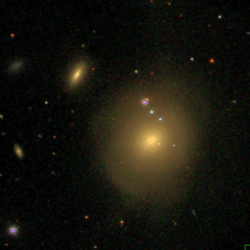NGC 736
NGC 736 is an elliptical galaxy in the constellation Triangulum. It is an estimated 200 million light years from the Milky Way and has a diameter of approximately 85,000 light years. NGC 736 was discovered on September 12, 1784 by the German-British astronomer William Herschel.[5][6][7]
| NGC 736 | |
|---|---|
 SDSS image of NGC 736 | |
| Observation data (J2000 epoch) | |
| Constellation | Triangulum |
| Right ascension | 01h 56m 40.871s[1] |
| Declination | +33° 02′ 36.67″[1] |
| Redshift | 0.014567[2] |
| Helio radial velocity | 4335 km/s[2] |
| Distance | 191.8 Mly (58.80 Mpc)[3] |
| Apparent magnitude (V) | 12.13[4] |
| Apparent magnitude (B) | 13.6[2] |
| Absolute magnitude (V) | -21.6[4] |
| Characteristics | |
| Type | E[2] |
| Other designations | |
| UGC 1414, MCG+05-05-028, PGC 7289[2] | |
See also
References
- Skrutskie, M. (2006). "The Two Micron All Sky Survey (2MASS)". The Astronomical Journal. 131 (2): 1163–1183. Bibcode:2006AJ....131.1163S. doi:10.1086/498708.
- "NGC 736". SIMBAD. Centre de données astronomiques de Strasbourg. Retrieved 2020-05-24.
- Crook, Aidan C.; Huchra, John P.; Martimbeau, Nathalie; Masters, Karen L.; Jarrett, Tom; Macri, Lucas M. (2007). "Groups of Galaxies in the Two Micron All Sky Redshift Survey". The Astrophysical Journal. 655 (2): 790–813. arXiv:astro-ph/0610732. Bibcode:2007ApJ...655..790C. doi:10.1086/510201.
- "Results for object NGC 0736 (NGC 736)". NASA/IPAC Extragalactic Database. California Institute of Technology. Retrieved 2020-05-24.
- Ford, Dominic. "The galaxy NGC 736 - In-The-Sky.org". in-the-sky.org. Retrieved 2020-03-29.
- "Revised NGC Data for NGC 736". spider.seds.org. Retrieved 2020-03-29.
- "Your NED Search Results". ned.ipac.caltech.edu. Retrieved 2020-03-29.
This article is issued from Wikipedia. The text is licensed under Creative Commons - Attribution - Sharealike. Additional terms may apply for the media files.